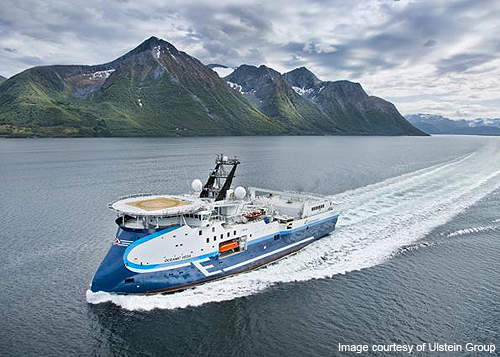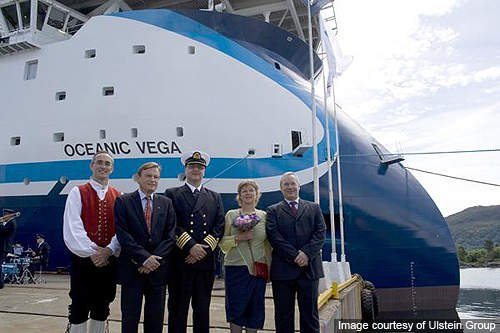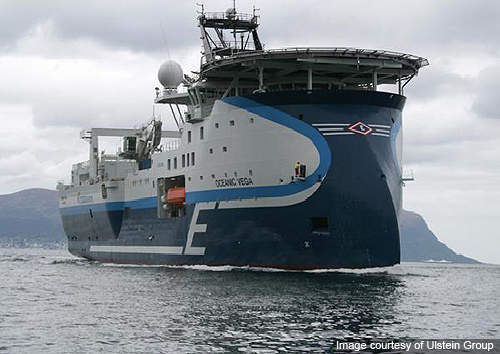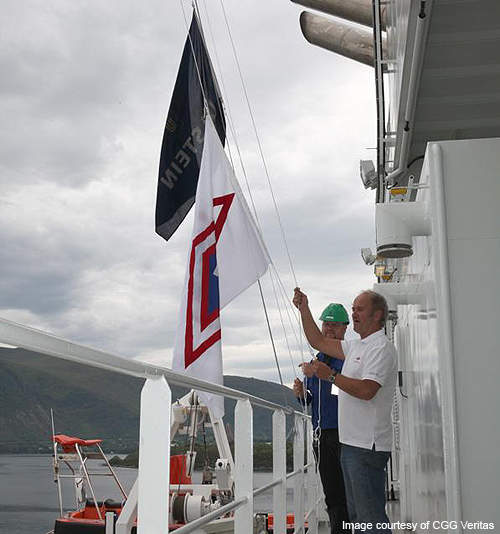Oceanic Vega is the first of the two SX120 type seismic research vessels built by Ulstein Design & Solutions. The ship is owned by the Eidesvik and CGG Veritas joint venture.
In July 2007, Eidesvik signed a NOK1.3bn contract with Ulstein Verft for two SX120 type seismic vessels. The first ship, Oceanic Vega completed sea trials in June 2010. The ship was christened and delivered in July 2010. The second ship, Oceanic Sirius was launched in September 2009 and delivered in October 2011.
Oceanic Vega will serve a 12-year charter with an option of a further five years for geophysical exploration specialists CGG Veritas.
Technical specifications
The Oceanic Vega has an overall length of 106m and a perpendicular length of 99.3m.
The moulded breadth at main deck is 24m and maximum breadth is 28m. The depth from the main deck is 10m. The vessel has a maximum draught of 8m and design draught of 7m.
The 5,530dwt ship can sail at a maximum speed of 17kt. The bollard pull of the vessel is around 190t. The ship can complement 70 personnel. The Oceanic Vega has received DNV clean design class notation and certificates for its lower impact on the environment.
Oceanic Vega design and features
Based on the X120 model, the Oceanic Vega features the X-BOW hull line design developed by Ulstein Design & Solution.
This innovative hull design delivers superior handling in furious marine conditions and also reduces the hydrodynamic drag to achieve excellent fuel efficiency.
The vessel is capable of operating in both Equatorial and Arctic waters. It delivers a towing force of 140t during seismic operations.
The vessel can be deployed in 3D, 4D or high-resolution seismic acquisition projects. The ship uses a sixteen streamer configuration. The Oceanic Vega can store 3,300m³ of fuel oil, 550m³ of fresh water and 4,700m³ of ballast water.
Classified under ICE-C class, the Oceanic Vega can operate in cold waters. The vessel is designed to conduct operations throughout its life with docking intervals. It complies with the redundant propulsion notation of DNV. The ship is equipped with enough instrumentation to carry out maintenance at sea. The refuelling is conducted by dedicated support vessels.
Ship systems
The instrument room at the stern is placed above the seismic area. It features large windows facing the sea.
A gantry crane with a capacity of 2 x 7.5t, serves the storage area located on the instrument room. The two deck cranes installed on C-deck mid-ship have a capacity of 15t at 18m.
The ship is equipped with a Nautilus acoustic and steering device, 20 streamer reels for 8,000m Sentinel solid streamers, 16/20 tow points, two 3-4 sub-arrays dual air-gun source, and a GunLink 4000 digital gun controller for reduced seismic offset.
The ship has a helicopter deck at the bow to accommodate a single helicopter. There are two work boats available for maintenance of in-water equipment.
There are also information and communication systems, navigation systems, an integrated automation system and a fuel overflow tank system. The ship features a bilge water cleaning system and incinerator for treatment of garbage and disposals.
Propulsion
The vessel is powered by a diesel-electric propulsion system. Each of the four main generator engines is rated at 3745ekW and the two main generator engines are rated at 1870ekW each. Two main controllable pitch and variable speed propellers are driven by two electrical tandem propulsion motors. This propulsion configuration allows the speed control of around 5kt during seismic acquisition.
Accommodation facilities
The ship has 61 cabins, of which 52 are single and nine double. There are four day rooms for leisure activities for the crew. Other facilities include a mess room and a galley.











